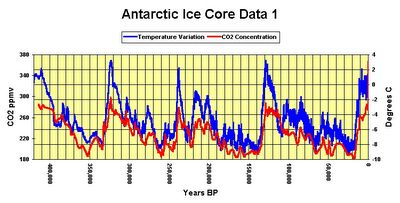
The graph above includes data from the Nature paper, plus data from other studies referenced below. Notice how CO2 concentration rises vertically at the end of the time series. The increase appears vertical because of the large time scale, but it actually occurs over the past 150 years, which corresponds to the age of fossil fuels (the modern industrial age). Notice too that there hasn't been a corresponding increase in temperature during this time period. This is probably due to the ability of the oceans to function as a heat sink, and thereby delay the increase in atmospheric temperatures. However, there are recent indications that the oceans are now warming, which will reduce their ability to act as a heat sink.
Thus we seem to be headed for some very large climate changes. Temperatures could increase rapidly, and then decrease just as rapidly--as they have repeatedly over the past 420,000 years. Another possibility is that there will be so much GTGs in the atmosphere that they will actually override historical patterns of thermohaline circulation and climate change. It's noteworthy in this context that the current atmospheric methane level is about 230% of its pre-industrial maximum (contrasted with CO2 being about 130% of its pre-industrial maximum).
Given all the new ice core data, what changes can we anticipate for our climate? If CO2 has increased over the past 150 years as much as it normally increases over thousands of years leading up to an interglacial phase (about 80 ppmv), then we could expect as much as a corresponding 10-12C increase in temperature.
It seems the northern hemisphere is affected more by global temperature changes than the southern hemisphere. This could be explained by the fact that the North Polar sea ice is much thinner and much less extensive than the South Polar continental ice, and is therefore much more susceptible to melting under warm conditions, thereby precipitating shifts or shutdowns in the thermohaline circulation. The mass of North Polar sea ice has thinned by at least 50% in just the past 30 years.
Research also indicates that a large variation in climate is likely to occur over a relatively short period of time. It is a Tipping Point scenario, where small fluctuations beyond a certain trigger point lead to a runaway effect.
For further reading on this subject, go to: http://www.daviesand.com/Choices/Precautionary_Planning/
New_Data/
No comments:
Post a Comment